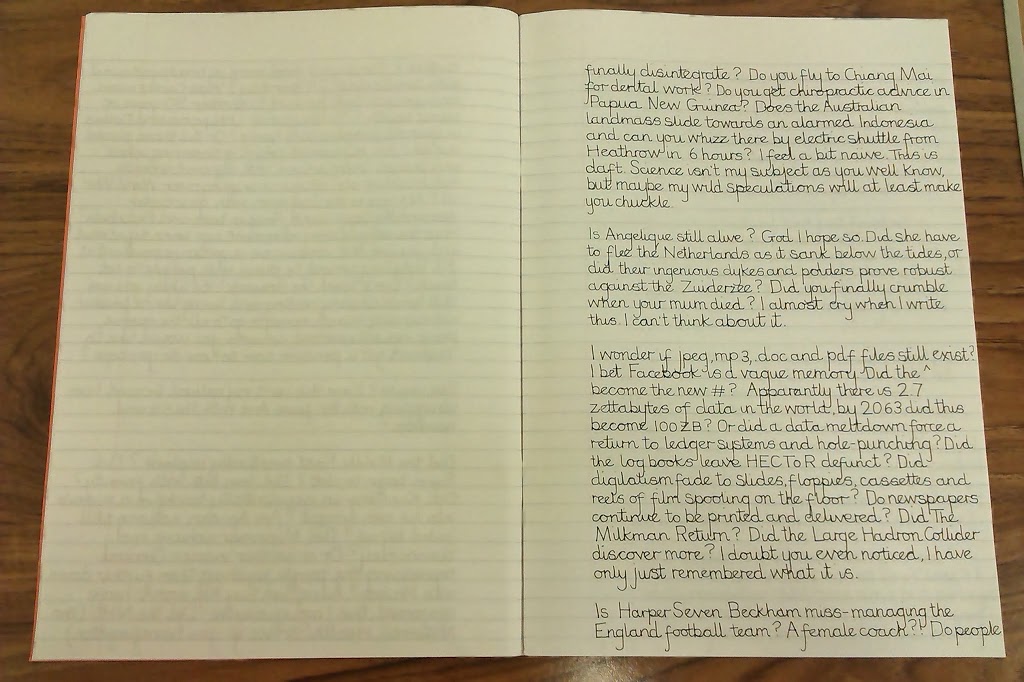Writing out and out speaking ageing

By Kay Steven, Curator of OUTING AGEING
Inside the gallery
What do you remember about learning to write? I remember a project notebook – and concentrating hard on the movement of the pencil. Creating little tails. Lifting the pencil at the right moment. There was a focus on the shape – repetition – getting it right.
To create her piece, Rachel Magdeburg has taken the time to try to relearn writing skills. To write with evenness and consistency requires a discipline of mind and action. Rachel told me that she had to almost trick her mind to adapt itself to producing something with different tools. Not that she can’t write – but her stye of writing has changed considerably since school. No longer as regimented. No longer consistent.
Writing is something we have stopped practising. We are too busy with our keyboards, our thumbs on twitter. Marks made on the page are hurried. Yet tiny details reveal something about us – our state of mind.
In practising her writing Rachel has reconnected with an earlier part of herself and simultaneously engaged with her present self and its habits and practices. The younger pliable mind is a shadow of its former self. Puzzled perhaps that it cannot just write at will. It has to fight to connect hand with mind, mind with hand. Practising handwriting encounters already well practised rituals. There is an unseen collision of past, present and future. There is no backspace, no crossing out. It is tiring to use fingers and thumbs. There is a lack of a familiar rhythm.
Rachel uses the process to create a memo to her future self. She dares to use handwriting from the past to explore future notions of herself – which she will at some point read in her future present and look back!
When she revisits the memo, will she be surrounded by old school jotters in attics. Will the handwritten notebooks of today become the artist’s notebook of the future – not paint and brush but quill and ink? Does today’s text becomes the future’s sketch?
I like the physicality of the work and the humour of if. The thoughts we all play around with in our head but are too scared to reveal are pinned down on the page. The uniformity of the well considered words seem to give the serious and monotonous nature of ageing, room to breath. You have to stay with the material for a while – word on word, line on line.
Outside the gallery
I sat with some older people. We sat round a textile covered table. First introductions. Second words. Words that preyed on our minds forced their way out.
What am I going to do?
How can I live?
My identity – where will it come from – it is so wrapped up in my work and now I have to stop,
70 years old – why that’s awesome.
70 years old. It means something but it doesn’t relate to what is going on inside me, in my life.
MORTALITY
MOBILITY
Caged animal at 70?
UNspeakable
Come and contribute to the Outing Ageing discussion this Friday 18th October, 19.00-21.00. The event is free and will be chaired by Marika Rose from Durham University. It will feature contributions by Dr Cathy Bailey, Research Fellow in International Ageing at Northumbria University, Moyra Riseborough, a researcher currently working with the Centre for Ageing and Vitality at Newcastle University and Fr Colin Carr, local intellectual and Catholic priest. This will be an opportunity for both the artists and the public to reflect on how the work in the show engages with broader notions of ageing, wisdom, maturity and death.